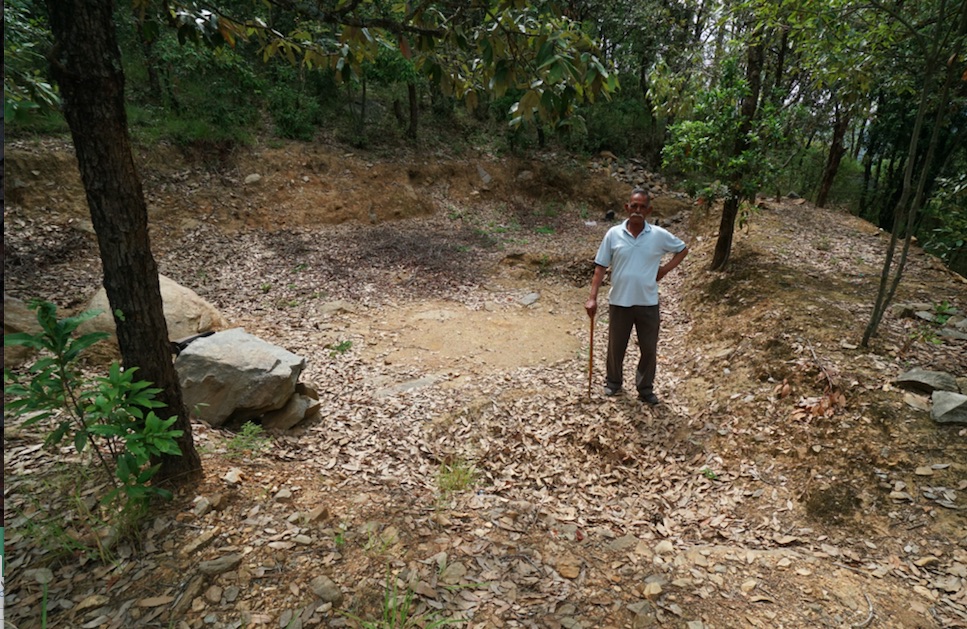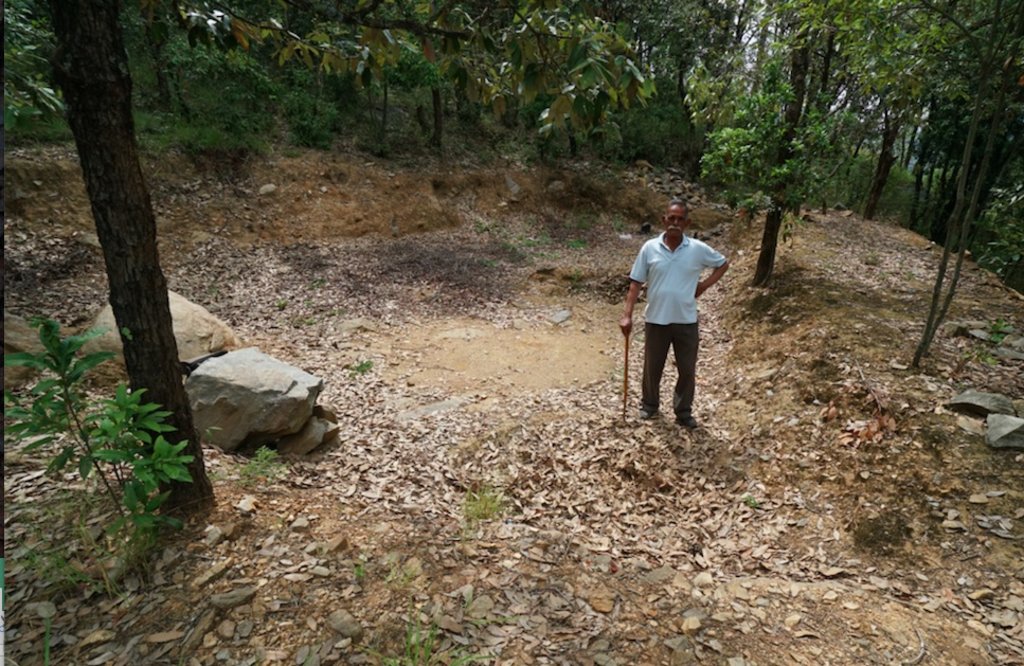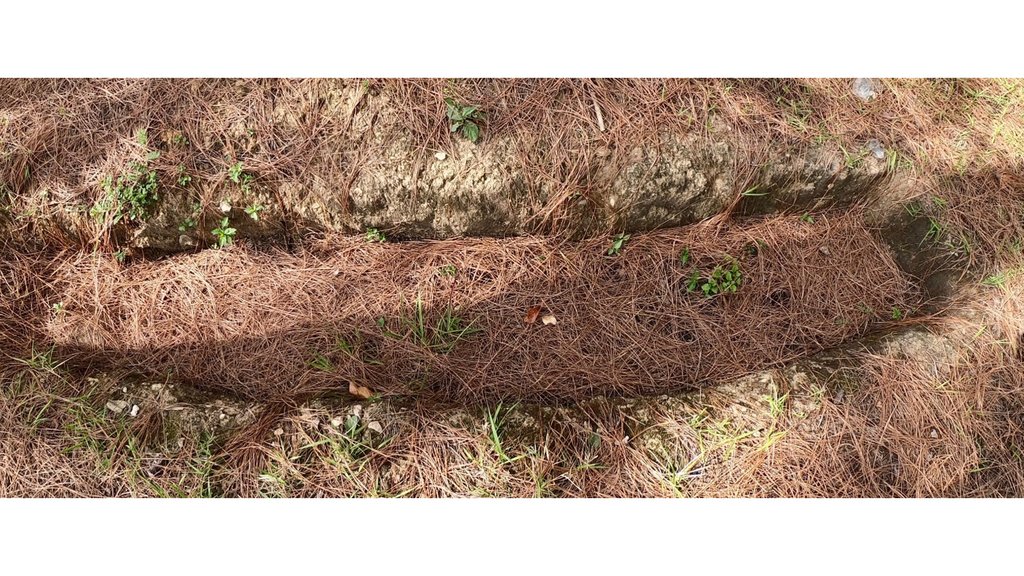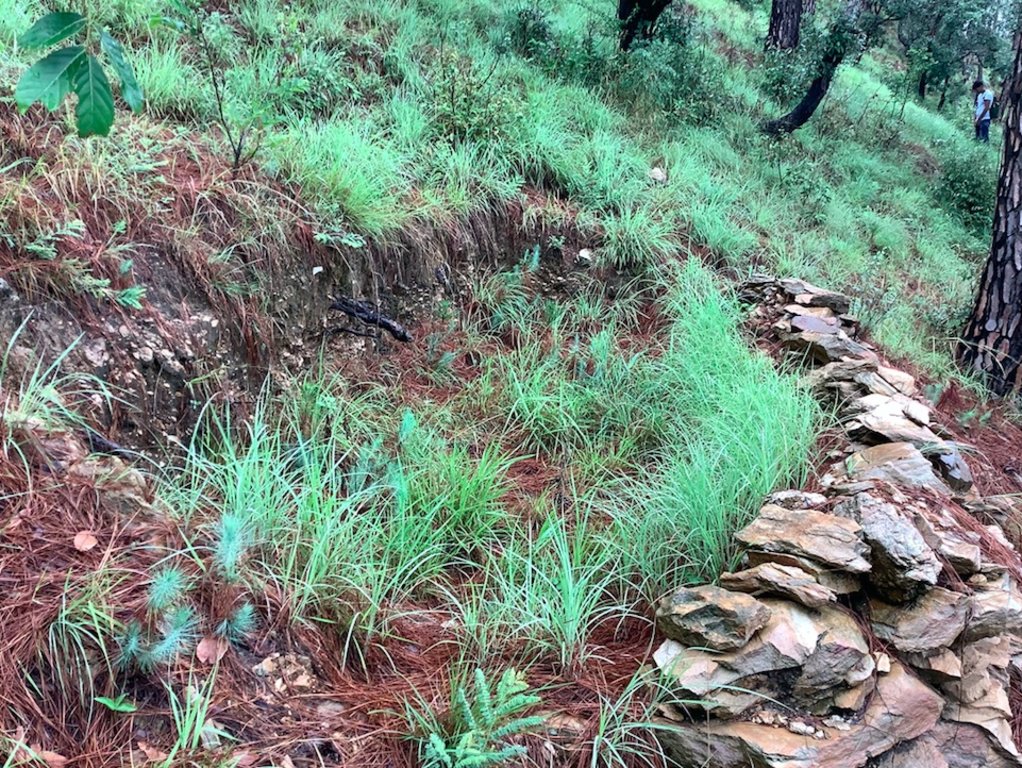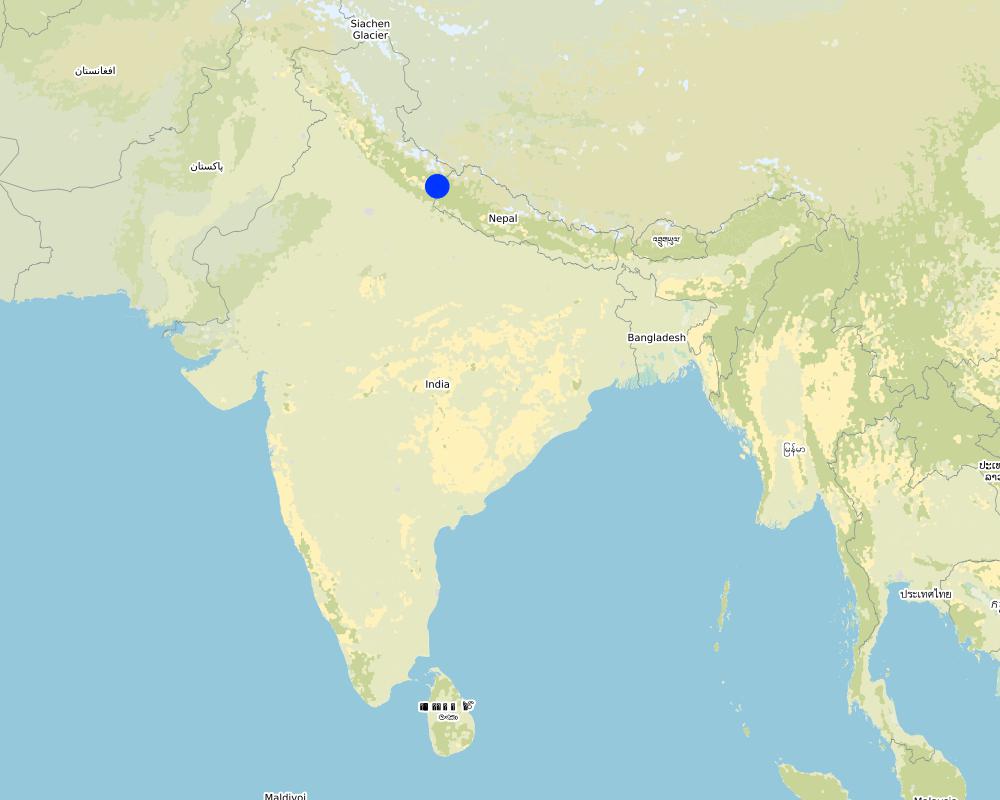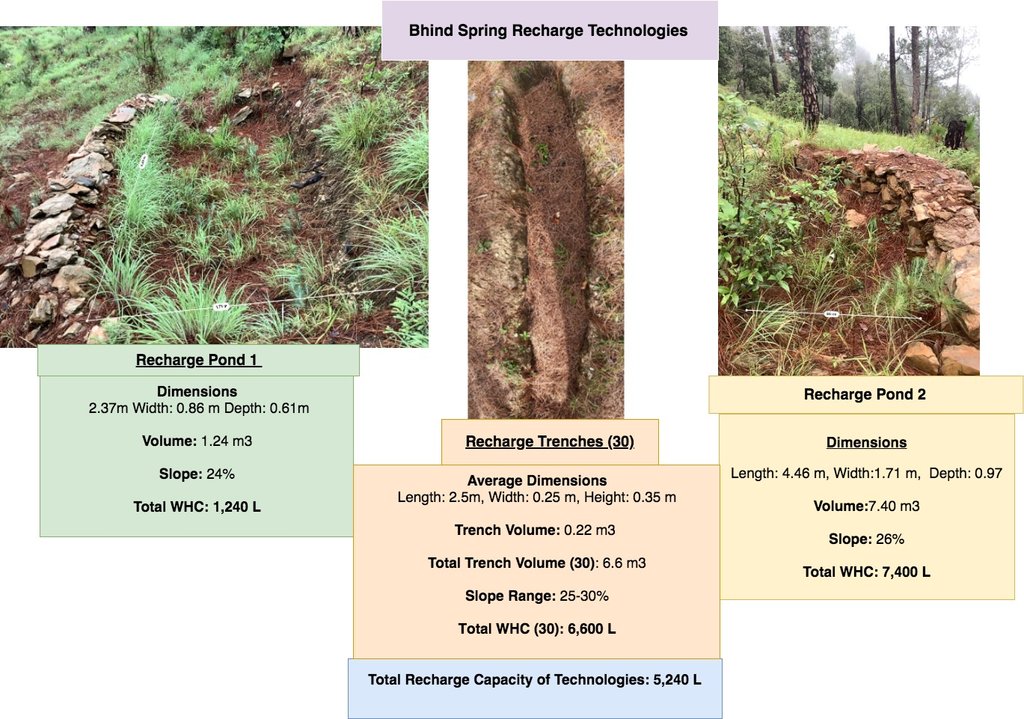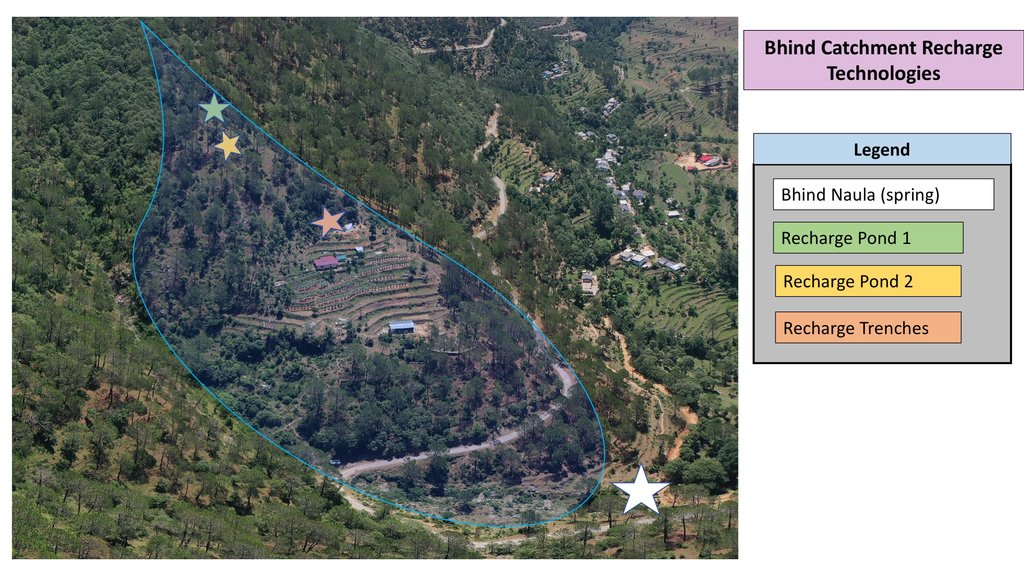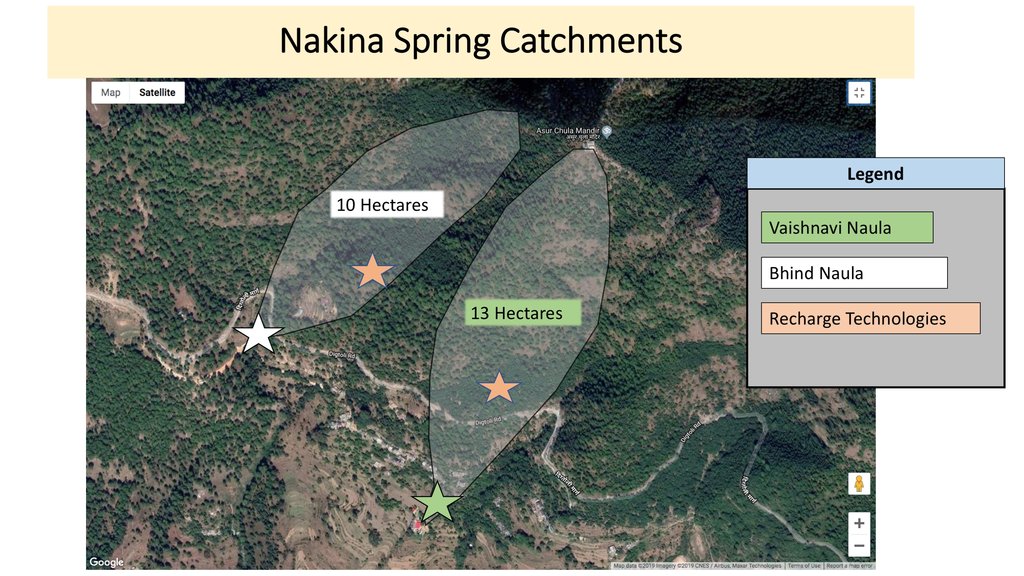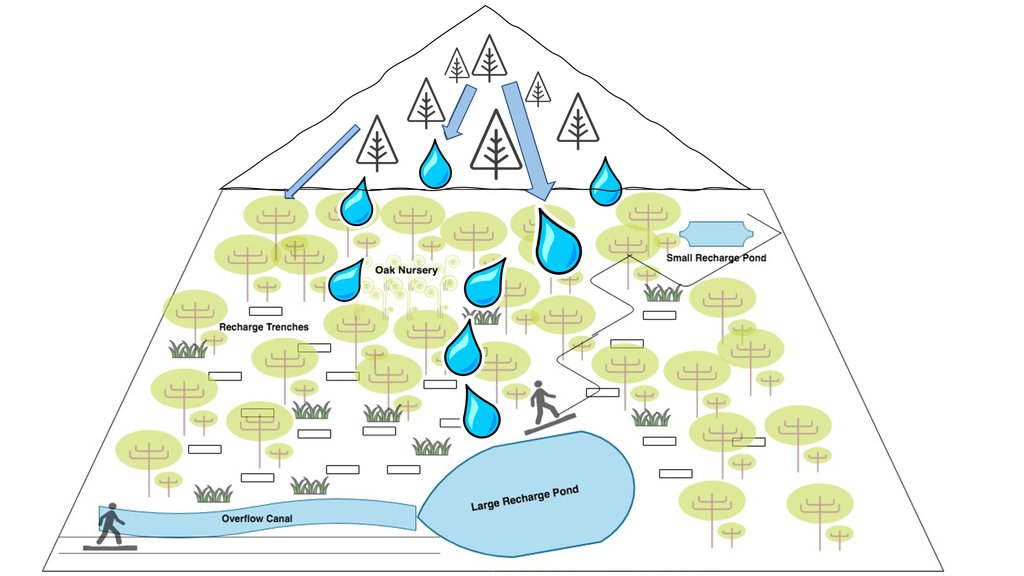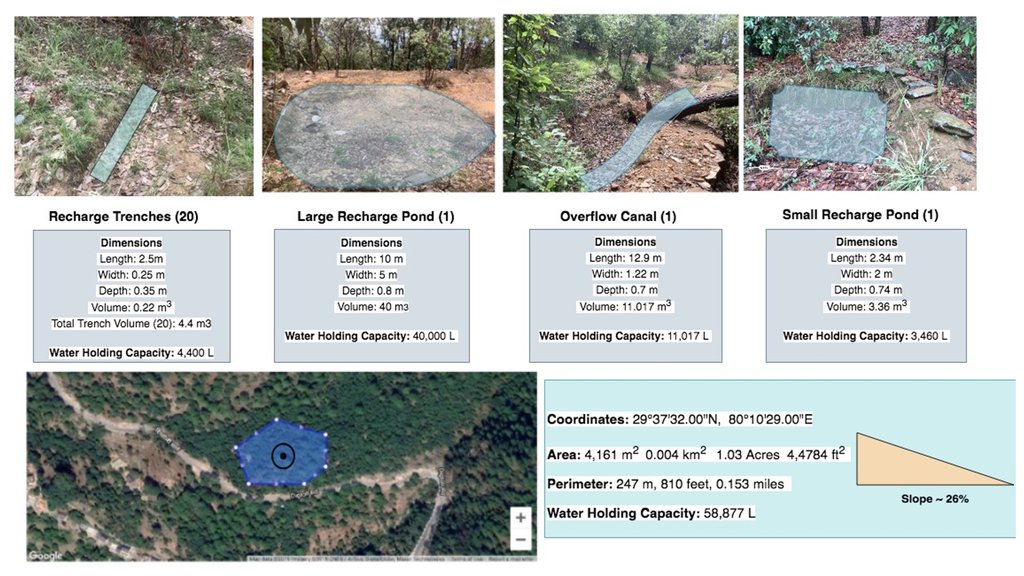Recharge Ponds and Recharge Trenches [印度]
- 创建:
- 更新:
- 编制者: Jaclyn Bandy
- 编辑者: –
- 审查者: Hanspeter Liniger, Rima Mekdaschi Studer
Chaal or Khals (recharge pond) and Khanti (recharge trenches)
technologies_5193 - 印度
查看章节
全部展开 全部收起1. 一般信息
1.2 参与该技术评估和文件编制的资源人员和机构的联系方式
关键资源人
土地使用者:
Joshi Jagdamba Prashad
Naikina Forest Head Council (Gram Panchayat)
印度
有助于对技术进行记录/评估的项目名称(如相关)
Onsite and Offsite Benefits of SLM有助于对技术进行记录/评估的机构名称(如相关)
ICIMOD International Centre for Integrated Mountain Development (ICIMOD) - 尼泊尔有助于对技术进行记录/评估的机构名称(如相关)
G.B. Pant Institute of Himalayan Einvironment & Development (G.B. Pant Institute of Himalayan Einvironment & Development) - 印度1.3 关于使用通过WOCAT记录的数据的条件
编制者和关键资源人员接受有关使用通过WOCAT记录数据的条件。:
是
1.4 所述技术的可持续性声明
这里所描述的技术在土地退化方面是否存在问题,导致无法被认为是一种可持续的土地管理技术?:
否
注释:
Like any tool, one needs to use and apply it appropriately. Land users and SLM specialists have admitted that these technologies can be ineffective depending on number, design and site selection for implementation. Recharge ponds and trenches could potentially cause soil disturbance and subsequent land degradation if such measures are not carefully considered by the users.
1.5 参考关于SLM方法(使用WOCAT记录的SLM方法)的调查问卷
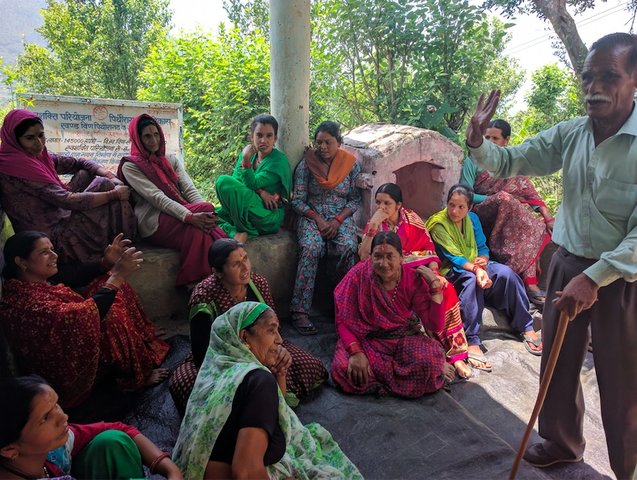
Community Forest Management in the Nakina Van Panchayat [印度]
Van Panchayats or village forest councils are a impressive example of grassroots community management of natural resources, where a specific administrative unit is locally elected by community members who are responsible for the management of activities related to the forest.
- 编制者: Jaclyn Bandy

Naula Management and Conservation [印度]
Naulas are shallow, four-sided stepped wells designed to collect water from subterranean seepages or springs and are used to meet domestic water needs by the local communities. Naula management and conservation encompasses a range of activities that preserve their structure and function.
- 编制者: Jaclyn Bandy
2. SLM技术的说明
2.1 技术简介
技术定义:
Recharge ponds (Chaals or khals) and recharge trenches (khanti) are common methods to catch the surface runoff and increase the infiltration to recharge groundwater and aid in natural spring recharge in the middle mountain regions.
2.2 技术的详细说明
说明:
1. The recharge ponds and trenches have been applied in mountainous community forests. There have been about 60 trenches, 1 large and 4 small recharge ponds constructed in the specific sites in the community forest of Naikina. These are ideal areas to implement these technologies, as they encompass the microwatershed/springsheds of 3 springs.
a. Recharge ponds are circular or rectangular dugout structures which were constructed a natural depression area on sloping land. The standard size is usually as follows: Length =3 m, Width =3 m and Depth = 0.7 m, with site specific modifications. Water feeder channels which flow to the ponds helps to harvest additional surface flow. The walls are not vertical but have a 45 degree slope to prevent cave in.
b.Recharge trenches are small rectangular structures of typical dimensions: Length=1.5 m, Width= 1m , Depth= 0.7 m, constructed on sloping land in a staggered manner. The slope of the walls should be not more than 45 degrees, and the size of the trenches and their spacing depends on the slope of the land. In higher slope areas, one should construct smaller staggered trenches with closer spacing. These are generally made in high rainfall areas, as there is an increased danger of overflow. In staggered trenching, the trenches are located directly below one another in alternate rows and in a staggered fashion. These may be 2 m to 3 m long and the spacing between the rows may vary from 3 m to 5 m.
2. Aims/Objectives: The central focus of the technology is water conservation and harvesting of surplus monsoon runoff to recharge groundwater reservoirs, which is otherwise going un-utilized. Additionally, land degradation by water erosion is decreased due to slowing of runoff and increased soil infiltration. Water erosion after intense rainfall affects both onsite and offsite sites, causing soil displacement, increased frequency of landslides, damage to vegetation, agriculture land, and village settlements.
3. Methods: Due to decreased spring discharge in the dry season and high dependency on the springs for drinking water (humans and livestock), the community has implemented these technologies within in catchment areas of 3 essential springs (Bhind, Vaishnavi, and Bagawoti) in the last 3 years.
4. Stages of Implementation: Awareness building, community mobilization, and central planning was done by the head of the Forest Council (Gram Panchayat), Mr. Jagdamba Joshi. Recharge pond and trench construction was done over the course of a month by different villagers that were available to participate. They were incentivized to work with a small compensation of 5.30 USD (400 INR)/day. Activities and inputs included time and manual labor (about 3 days for the large recharge pond, 0.5-1 day for each of the small recharge ponds, and 4 days for 60 recharge trenches) and appropriate land-use planning and management. Primarily, the strategic construction of these technologies and selection in appropriate springshed recharge/catchment areas has led their success. The structures have been placed below the pine forest, (which generates high runoff) and reside in a restored broadleaf forest, which acts like a sponge to retain the runoff water flowing down from the pine forest above. The ponds lies in a natural, leveled depression with gentle slopes around. Broadleaf/oak dominated forest areas have been increasingly supported as technology construction sites, as the placement further improves of groundwater recharge.
To assure long-term effectiveness, maintenance and re-digging of the recharge ponds and trenches is carried out by villagers annually, pre-monsoon.
5. Gram Panchayat, Mr. Joshi has played a key role in informing the villagers of technology design, function and importance for supporting the community forest and subsequent spring recharge. He has previous knowledge of the application of these technologies through first-hand experiences working in the army. The villagers were solely responsible for construction with Mr. Joshi's guidance. The men were mainly responsible for making recharge ponds and the women dug trenches and removed weeds.
6) Technology benefits/impacts acknowledged by the community: moisture conservation, long-term groundwater recharge, spring recharge, reduction of soil-water erosion, improved infiltration and support for vegetation cover and broadleaf/oak forest.
Like: Relatively simple and inexpensive, little external inputs required, effective in short and long-term (provided site appropriate selection and regular seasonal rainfall)
Dislike: Drudgery, time consuming, maintenance required, distance (site of implementation may also be far from village).
2.3 技术照片
2.5 已应用该技术的、本评估所涵盖的国家/地区/地点
国家:
印度
区域/州/省:
Uttarakhand
有关地点的进一步说明:
Nakina Village, Pithoragarh Bloc
具体说明该技术的分布:
- 适用于特定场所/集中在较小区域
技术现场是否位于永久保护区?:
是
如果是,请具体说明:
The technologies are located in a community protected forest, which has been under sole village management since the early 1950's.
注释:
A large and small recharge pond above the roadside lies adjacent to a protected oak nursery.
Map
×2.6 实施日期
注明实施年份:
2016
2.7 技术介绍
详细说明该技术是如何引入的:
- 通过土地使用者的创新
- 通过项目/外部干预
注释(项目类型等):
Mr. Jagdamba Joshi's self-started initiative in his community can be attributed to his personal work experience. While serving in the army, he was trained to build ponds and trenches. Through his own observations and perception of these technologies, he was certain they would help support the depleting groundwater.
3. SLM技术的分类
3.1 该技术的主要目的
- 减少、预防、恢复土地退化
- 保护生态系统
- 结合其他技术保护流域/下游区域
- 降低灾害风险
- 适应气候变化/极端天气及其影响
- 创造有益的社会影响
3.2 应用该技术的当前土地利用类型
同一土地单元内混合使用的土地::
是

森林/林地
- (半天然)天然森林/林地
- 植树造林
(半天然)天然森林/林地:具体说明管理类型:
- 选伐
(半)天然林类型:
- 亚热带山地系统天然植被
- Broadleaf/pine mixed forest
植树造林:说明树种的起源和组成:
- 混交品种
植树造林类型:
- 亚热带干林人工林 - 阔叶林
- Quercus leucotrichophora, Quercus lanata, Quercus semecarpifolia, , Quercus glauca Thumb, Pyrus pasia, Myrica eaculanta and Rhododendron arborium
以上的树木是落叶树还是常绿树?:
- 落叶植物
产品和服务:
- 木材
- 薪材
- 自然保持/保护
3.3 由于技术的实施,土地使用是否发生了变化?
由于技术的实施,土地使用是否发生了变化?:
- 否(继续问题3.4)
3.4 供水
该技术所应用土地的供水:
- 雨养
3.5 该技术所属的SLM组
- 集水
3.6 包含该技术的可持续土地管理措施

结构措施
- S4:平沟、坑
- S5:大坝、集水斗、水池
3.7 该技术强调的主要土地退化类型

土壤水蚀
- Wt:表土流失/地表侵蚀
- Wg:冲沟侵蚀/沟蚀
- Wm:块体运动/滑坡
- Wo:场外劣化效应

水质恶化
- Hs:地表水良变化
- Hg:地下水/含水层水位的变化
3.8 防止、减少或恢复土地退化
具体数量名该技术与土地退化有关的目标:
- 减少土地退化
- 修复/恢复严重退化的土地
4. 技术规范、实施活动、投入和成本
4.1 该技术的技术图纸
技术规范(与技术图纸相关):
Bhind Catchment (Springshed) Recharge Technologies
Dimensions
Recharge Pond 1- Length: 2.37m Width: 0.86 m Depth: 0.61m
Pond 1 Volume- 1.24 m3
Slope: 24%
Recharge Pond 2- Length: 4.46 m, Width: 1.71 m, Depth: 0.97
Pond 2 Volume- 7.40 m3
Slope: 26%
Recharge Trench- Length: 2.5m, Width: 0.25 m, Height: 0.35 m
Trench Volume: 0.22 m3
Total Trench Volume (30): 6.6 m3
Spacing: Trenches are in different locations of the Bhind springshed, 20 functional trenches are aggregated within 1m of each other in a broadleaf forest just north on the cucumber farm. 10 trenches are located directly above the Cucumber farm.
Slope Range: 25-30%
Water Holding Capacity (L):
Total Capacity of Recharge Pond 1: 1,240 L
Total Capacity of Recharge Pond 2: 7,400 L
Total Capacity of Trenches (30): 6,600 L
Total WHC of Technologies: 15,240 L
Total Catchment area of Bhind Springshed: ~10 Hectares
作者:
Jaclyn Bandy
日期:
25/07/2019
技术规范(与技术图纸相关):
Nakina Spring Catchments (springsheds) and Technology Locations
作者:
Jaclyn Bandy
日期:
25/07/2019
技术规范(与技术图纸相关):
Technologies in Vaishinavi Springshed
Dimensions:
Large Recharge Pond- Length: 10m, Width: 5m, Depth: 0.8 m
Large Pond Volume: 40 cubic meters (m3)
Overflow Canal (narrow pond adjacent to large recharge pond)
Dimensions:
Overflow Canal- Length: 12.9 m, Width: 1.22 m, Depth: 0.7cm
Overflow Canal: 11.017 m3
Small Recharge Pond- Length: 2.34 m, Width: 2 m, Depth: 0.74 m
Small Pond Volume: 3.36 m3
Recharge Trench- Length: 2.5m, Width: 0.25 m, Height: 0.35 m
Trench Volume: 0.22 m3
Total Trench Volume (20): 4.4 m3
Spacing: trenches within 0.5m of each other and <1m spacing between trenches and broadleaf trees and other bushes
Slope: 26%
Water Holding Capacity (L):
Total Capacity of Large Pond: 40,000 L
Total Capacity of Overflow Canal: 11,017 L
Total Capacity of Small Pond: 3,460 L
Total Capacity of Trenches (20): 4,400 L
Total WHC of Technologies: 58,877 L
Total Area of Technologies: 0.5 Hectare
Total Area of Vaishnavi Catchment: ~13 Hectares
作者:
Jaclyn Bandy
日期:
25/07/2019
4.2 有关投入和成本计算的一般信息
具体说明成本和投入是如何计算的:
- 每个技术单元
指定单位:
2 Ponds, 1 Overflow Canal, 20 Recharge trenches
指定单位面积(如相关):
Total Trenches (20): 4.4 m3, Large Recharge Pond: 40 m3, Overflow Canal: 11.017 m3, Small Recharge Pond: 3.36 m3
其它/国家货币(具体说明):
INR
如相关,注明美元与当地货币的汇率(例如1美元=79.9巴西雷亚尔):1美元=:
70.0
注明雇用劳工的每日平均工资成本:
400 INR
4.3 技术建立活动
| 活动 | 时间(季度) | |
|---|---|---|
| 1. | Plan designed by administrative committee of Van Panchayat | Winter 2016 |
| 2. | For technology construction, groups of men and women (8 total per group) were established with their planned working days | Pre-monsoon 2016 |
| 3. | Trenches and recharge ponds were dug on a rotation system by the groups on different days | Pre-monsoon 2016 |
| 4. | Compensation was given to participants upon completion of the project after 20 days work. | Pre-monsoon 2016 |
4.4 技术建立所需要的费用和投入
| 对投入进行具体说明 | 单位 | 数量 | 单位成本 | 每项投入的总成本 | 土地使用者承担的成本% | |
|---|---|---|---|---|---|---|
| 劳动力 | Community manual labor | person-days | 120.0 | 400.0 | 48000.0 | 100.0 |
| 设备 | pick | pieces | 5.0 | 300.0 | 1500.0 | 100.0 |
| 设备 | shovel | pieces | 5.0 | 500.0 | 2500.0 | 100.0 |
| 设备 | pharuwa (hoe) | pieces | 4.0 | 300.0 | 1200.0 | 100.0 |
| 设备 | khanti (digging bar) | pieces | 3.0 | 1500.0 | 4500.0 | 100.0 |
| 设备 | hammer | pieces | 3.0 | 2000.0 | 6000.0 | 100.0 |
| 设备 | small hammer | pieces | 3.0 | 300.0 | 900.0 | 100.0 |
| 设备 | chino (chisel) | pieces | 4.0 | 500.0 | 2000.0 | 100.0 |
| 施工材料 | Rocks excavated on site | |||||
| 技术建立所需总成本 | 66600.0 | |||||
| 技术建立总成本,美元 | 951.43 | |||||
注释:
On average 4 people worked on establishing the technology/day = 400 x 4 = 1600 (labor cost/day)
1600 x 30 days = 48,000 Total Cost
4.5 维护/经常性活动
| 活动 | 时间/频率 | |
|---|---|---|
| 1. | Monitoring of the area for any damages or maintenance required | Weekly |
| 2. | Clearing of debris or filled sediment in pond/trenches/channel | Pre monsoon |
4.6 维护/经常性活动所需要的费用和投入(每年)
| 对投入进行具体说明 | 单位 | 数量 | 单位成本 | 每项投入的总成本 | 土地使用者承担的成本% | |
|---|---|---|---|---|---|---|
| 劳动力 | Maintenance Labor | person-days | 4.0 | 1600.0 | 6400.0 | 100.0 |
| 设备 | Communal equipment (see above for costs) | |||||
| 技术维护所需总成本 | 6400.0 | |||||
| 技术维护总成本,美元 | 91.43 | |||||
4.7 影响成本的最重要因素
描述影响成本的最决定性因素:
-Amount of siltation accumulated in the recharge structures (more debris/soil accumulation requires more maintenance and labor days)
-Labor availability
5. 自然和人文环境
5.1 气候
年降雨量
- < 250毫米
- 251-500毫米
- 501-750毫米
- 751-1,000毫米
- 1,001-1,500毫米
- 1,501-2,000毫米
- 2,001-3,000毫米
- 3,001-4,000毫米
- > 4,000毫米
指定年平均降雨量(若已知),单位为mm:
1500.00
有关降雨的规范/注释:
Monsoon- mid-June to mid-September; July and August are the rainiest months and the temperature is warm and moist; between 70-85% of the annual precipitation occurs in the monsoon season
Seasons
a. Winter or cold weather (mid Dec. - mid March)
b. Summer or hot weather (mid March - mid June)
c. Season of general rains (South - West monsoon season)
d. Season of retreating monsoon (mid September to mid November)
注明所考虑的参考气象站名称:
India Meteorological Department, Meteorological Centre Dehradun
农业气候带
- 半湿润
The overall climatic condition in the Pithoragarh district is governed by the southwest monsoon. It has a sub-tropical to temperate climate, with three pronounced seasons; summer, winter, and monsoon. The hilly terrain of the Himalayan region has snow cover and is cold during winter with snowfall normally occurring during the months of December to March.
Temperature- The temperature ranges from 0°C to 10°C in winter and from 8°C to 33°C in summer season. However, there is no meteorological observatory in the district. The account of the climate is based mainly on the records of the observations in the neighboring districts where similar meteorological conditions prevail. Variations in temperature are considerable from place to place and depend upon elevation as well as aspect. As the insolation is intense at high altitudes, in summer temperatures are considerably higher in the open than in the shade.
5.2 地形
平均坡度:
- 水平(0-2%)
- 缓降(3-5%)
- 平缓(6-10%)
- 滚坡(11-15%)
- 崎岖(16-30%)
- 陡峭(31-60%)
- 非常陡峭(>60%)
地形:
- 高原/平原
- 山脊
- 山坡
- 山地斜坡
- 麓坡
- 谷底
垂直分布带:
- 0-100 m a.s.l.
- 101-500 m a.s.l.
- 501-1,000 m a.s.l.
- 1,001-1,500 m a.s.l.
- 1,501-2,000 m a.s.l.
- 2,001-2,500 m a.s.l.
- 2,501-3,000 m a.s.l.
- 3,001-4,000 m a.s.l.
- > 4,000 m a.s.l.
说明该技术是否专门应用于:
- 凹陷情况
关于地形的注释和进一步规范:
Average Altitude of evaluated sites: 1850m
Average Slope: 25%
5.3 土壤
平均土层深度:
- 非常浅(0-20厘米)
- 浅(21-50厘米)
- 中等深度(51-80厘米)
- 深(81-120厘米)
- 非常深(> 120厘米)
土壤质地(表土):
- 粗粒/轻(砂质)
- 中粒(壤土、粉土)
土壤质地(地表以下> 20厘米):
- 中粒(壤土、粉土)
表土有机质:
- 中(1-3%)
- 低(<1%)
如有可能,附上完整的土壤描述或具体说明可用的信息,例如土壤类型、土壤酸碱度、阳离子交换能力、氮、盐度等。:
Mountain/hill soils are a collective name given to various types of soils found under the following conditions :
-under sub-tropical, temperate and sub-alpine conditions
-under various forest types
Characteristics: very thin, fertile, and may be less than a centimeter deep on steep slopes; they are mixed with pebbles, shingles (a mass of small rounded pebbles), and gravels; they have a low-medium water holding capacity. Angular and subangular fragments of parent rock may be found mixed with the lower layers of the mountain and hill soils.
Texture: varies from loamy to sandy loam.
Soil Reaction: ranges from acidic to neutral (pH 4.6 to 6.5)
Organic Matter content: 1-5%
Ferrugenous red roils are found in this district and are well developed over Himalayan rocks (quartzite, biotite schist, amphibolite schist). They are free of carbonates and deficient in nitrogen, humus and phosphorus, light textured, porous, and friable (brittle/crumbly). The soil depth ranges from about 10cm-75 cm. These soils may be grouped into two on basis of morphology
1. Red earths- loose, friable topsoil rich in secondary concretions (hard, compact mass of matter formed by the precipitation of mineral cement within the spaces between particles, and is found in sedimentary rock or soil)
2. Red loam- argillaceous soils having a blocky structure (argillaceous minerals may appear silvery upon optical reflection and are minerals containing substantial amounts of clay-like components, e.g. argillaceous limestones are limestones consisting predominantly of calcium carbonate, but including 10-40% of clay minerals)
Brown soil: is found particularly under dense broadleaved temperate and sub-alpine forests. There occurs a thick layer of humus on the forest floor (made of decomposed leaves, branches, twigs) and the topsoil is extremely rich in humus
Podsolic Soil: soil that has developed in humid/temperate conditions usually under coniferous forests (e.g. deodar, blue pine, fir, spruce) over quartzite, granites, schists and gneiss.
(Citation: Kumaun: The Land and the People, Sharad Singh Negi (1993)
5.4 水资源可用性和质量
地下水位表:
5-50米
地表水的可用性:
中等
水质(未处理):
良好饮用水
水质请参考::
地下水
水的盐度有问题吗?:
否
该区域正在发生洪水吗?:
否
关于水质和水量的注释和进一步规范:
Quantity: Water crisis has been a perennial problem in both the rural and urban areas of the Pithoragarh district
There is scarcity of safe drinking water of the villages in the study area. Hand pumps are often not functioning, pipe-water schemes are unreliable and the spring discharges have reduced during the dry season. Hand-pumped water often has a high iron content and bitter taste. Poor quality of groundwater in some of the naulas is mainly due to misuse and/or disuse of the structures.
A block-district groundwater resource estimation could not be carried out as the area is hilly (with slope >20%) and in major part aquifers are small, isolated bodies, and groundwater abstraction is done mainly through hand pumps and springs with small discharges.
However, we collected some physicochemical parameters that indicate the water (sourced from springs) is of good quality:
Water Quality Parameters of Springs:
pH: 6.29-8.18
Temp: 19.0-23.5 ºC
Electrical Conductivity: 109-504 µmsiemens
Total Dissolved Solids: 75-385 ppm
Other Parameters (from springs of nearby district, Champawat)
Electrical Conductivity: 127-222 µmsiemens
pH: 7.69-8.24
Calcium: 16-36 mg/l
Magnesium: 4.9-7.3 mg/l
Bicarbonate: 61-134 mg/l
Chloride: 5.3- 8.9 mg/l
Total Hardness as CaCO3: 70-110 mg/l
Source: Government of India Ministry of Water Resources, Central Ground Water Board, 2009 Groundwater Brochure of Champawat District (2009
5.5 生物多样性
物种多样性:
- 中等
栖息地多样性:
- 中等
关于生物多样性的注释和进一步规范:
Uttarakhand has more than 7000 species of medicinal plants and 500 species of fauna. Floral diversity contributes 31% of total floral density of India. Fauna contributes just 1.58% of the total faunal density of the country. There are 119 endemic species of flowering plants in the state that exhibited 2.35% endemism and 35 faunal endemic species. Because it lies at the juncture of India, Nepal and the Tibeten Autononmous region, there often cases of poaching and smuggling of wildlife contrabands, including bear bile, musk pods and leopard skins through the borders. Yarsa Gumba Ophiocordyceps sinensis, commonly known as Caterpillar Fungus, is also illegally traded transboundary in the region, together with various plant species. Due to anthropogenic impacts, changes is soil quality, and climatic elements, the biodiversity of our study site is not as high as in other areas of the Pithoragarh district.
Citation: Sundriyal, M. & Sharma, B. (2016). Status of Biodiversity in Central Himalaya, Applied Ecology and Environmental Sciences, 4( 2), 37-43.
5.6 应用该技术的土地使用者的特征
定栖或游牧:
- 定栖的
生产系统的市场定位:
- 生计(自给)
- 混合(生计/商业)
非农收入:
- 收入的10-50%
相对财富水平:
- 贫瘠
个人或集体:
- 团体/社区
机械化水平:
- 手工作业
性别:
- 女人
- 男人
土地使用者的年龄:
- 青年人
- 中年人
- 老年人
5.7 应用该技术的土地使用者使用的平均土地面积
- < 0.5 公顷
- 0.5-1 公顷
- 1-2 公顷
- 2-5公顷
- 5-15公顷
- 15-50公顷
- 50-100公顷
- 100-500公顷
- 500-1,000公顷
- 1,000-10,000公顷
- > 10,000公顷
这被认为是小规模、中规模还是大规模的(参照当地实际情况)?:
- 小规模的
5.8 土地所有权、土地使用权和水使用权
土地所有权:
- 社区/村庄
土地使用权:
- 社区(有组织)
用水权:
- 自由进入(无组织)
- 社区(有组织)
土地使用权是否基于传统的法律制度?:
是
具体说明:
Under the Kumaun Panchayat forest rules of 1931 (amended in 1976): the Van Panchayat (community forest council) is formed out of non-private land within the settlement boundaries of a village. Accordingly, all villagers are members of the VP upon their approval by a Sub-Divisional Magistrate under the state Revenue Department. The members are collectively referred to as the general body, which selects the management committee members through a democratic process.
注释:
5-9 elected members assume control of the forest and the extent of villager use. They additionally raise funds and mobilize the village to protect and support sustainable land use. Presently 12,089 Van Panchayats are entrusted with the management of over 5,449.64 km2 of forests.
5.9 进入服务和基础设施的通道
健康:
- 贫瘠
- 适度的
- 好
教育:
- 贫瘠
- 适度的
- 好
技术援助:
- 贫瘠
- 适度的
- 好
就业(例如非农):
- 贫瘠
- 适度的
- 好
市场:
- 贫瘠
- 适度的
- 好
能源:
- 贫瘠
- 适度的
- 好
道路和交通:
- 贫瘠
- 适度的
- 好
饮用水和卫生设施:
- 贫瘠
- 适度的
- 好
金融服务:
- 贫瘠
- 适度的
- 好
注释:
The situation of infrastructure is difficult and inconsistent in the hill regions because of the terrain. The major infrastructural issues are drinking water and irrigation facilities, electricity, transportation and communication facilities and social infrastructure (housing and education). As for financial services, only the State Bank of India (SBI) is active in the hill regions where it is trying to achieve the objective of 100% financial inclusion. Some villages mentioned buying into into agricultural insurance in the past, however this was a temporary enterprise and they were never compensated after extreme climatic events that occurred and damaged over 70% of their crop.
Though infrastructure and education has generally improved over the years, institutional and marketing networks in the region aimed at supporting hill-farmers are lacking.
6. 影响和结论性说明
6.1 该技术的现场影响
社会经济效应
生产
饲料生产
饲料质量
森林/林地质量
土地管理
注释/具体说明:
Constructing these technologies in the forest and within spring catchment areas has supported the village to work collaboratively and increased overall insightfulness to on-and-offsite effects and potentials of SLM.
收入和成本
农业投入费用
注释/具体说明:
Decreased the amount of supplementary fodder required for livestock. The amount of grasses, fodder, and fuelwood has increased with the help of strategic placement of recharge ponds and trenches.
工作量
注释/具体说明:
Less time spent collecting forest resources, as the area where the technology is near the village and supports fodder/fuelwood growth (broadleaf forest/oak nursery area)
社会文化影响
食品安全/自给自足
注释/具体说明:
Improved self sufficiency of village, as the technology has helped increase their water availability.
健康状况
注释/具体说明:
Water condition has improved. Their is less time spent collecting fodder in the forest, as these technologies have supported fodder tree and grass production.
土地使用权/用水权
注释/具体说明:
There is less friction between the villages of Bhurimuni and Nakina. Nakina did not have to go ask for permission to access the Bhurimuni Naula for water during the dry season.
文化机会
注释/具体说明:
The improvements of forest resource security and resilience to disasters/climatic extremes have allowed the villagers to spend more of their time building up a communal gathering area for ceremonial events and festivals around the Vaishnavi Temple.
娱乐机会
注释/具体说明:
There is more time for the women (1-2 hours saved) as the structural technologies have supported existing vegetation growth. This has reduced the time and distance required for gathering fodder an fuelwood.
社区机构
注释/具体说明:
The partnerships formed between land-users, the Nakina Van Panchayat, the Forest Department and external institutions are leading examples of necessary cooperation between all levels of governance for project harmonization.
SLM/土地退化知识
注释/具体说明:
People are taking forest management seriously and making innovative plans for further SLM interventions, whether it be community-initiated or with the help of external institutions/agencies.
冲突缓解
注释/具体说明:
Increased availability of resources has helped the overall morale of the village. This has further enhanced cooperation for interventions that require participation and effort in the community forest.
社会经济弱势群体的情况
生态影响
水循环/径流
水量
注释/具体说明:
The technologies act as a water reservoir and improve water holding capacity of the soil by decreasing runoff velocity.
水的回收/收集
地表径流
多余水的排放
地下水位/含水层
蒸发
土壤
土壤水分
土壤覆盖层
土壤流失
土壤堆积
土壤结壳/密封
土壤压实
土壤有机物/地下C
注释/具体说明:
Micro-catchments accumulate debris/silt washed down from upstream areas. When managed properly, this can function as a beneficial mulch to the soil, improving bioavailabiltiy of nutrients for plants.
生物多样性:植被、动物
植被覆盖
注释/具体说明:
Improved water availability and thus potential/support for vegetation growth and cover.
生物量/地上C
注释/具体说明:
Improves grasses and vegetation growth, and collects debris/silt from upstream areas.
植物多样性
注释/具体说明:
Micro-catchments provide water for native grasses, vegetation, and can help with the germination of seeds.
动物多样性
注释/具体说明:
Micro-catchments provide water and habitat for small animals/birds.
有益物种
注释/具体说明:
Micro-catchments provide water, habitat, and protection for microorganisms and insect species. They support native grasses and vegetation.
栖息地多样性
减少气候和灾害风险
滑坡/泥石流
注释/具体说明:
Decreased surface flow velocity
干旱影响
注释/具体说明:
Improved groundwater availability and enhanced spring recharge
飓风、暴雨的影响
注释/具体说明:
Erosion impacts from extreme rain storms is reduced by decreasing flow velocity
火灾风险
注释/具体说明:
Area is protected and forest is further enhanced by improved groundwater availability
微气候
注释/具体说明:
Decreased surface temperature due to improved vegetation/biomass, soil cover and water availability.
6.2 该技术的场外影响已经显现
水资源可用性
注释/具体说明:
Improved spring discharge in the peak dry season
旱季稳定可靠的水流
注释/具体说明:
Bhind and Vaishnavi Naulas (springs) have improved discharge in the peak dry season. According to villagers, there was little to no water available in May/June, and since 10 years the flow has returned due to improved forest management in combination with these structural technologies.
下游洪水
注释/具体说明:
impact of flash flood is minimized
下游淤积
注释/具体说明:
Helped slow down sediment and runoff
地下水/河流污染
注释/具体说明:
No direct evidence, but statements from the locals indicate that there are less sediments in the spring water ( due to improved soil infiltration and buffering capacity)
缓冲/过滤能力
对邻近农田的破坏
注释/具体说明:
Less damage from runoff
对公共/私人基础设施的破坏
注释/具体说明:
Decreased intensity of runoff on the roadside and settlement below
6.3 技术对渐变气候以及与气候相关的极端情况/灾害的暴露和敏感性(土地使用者认为的极端情况/灾害)
渐变气候
渐变气候
| 季节 | 增加或减少 | 该技术是如何应对的? | |
|---|---|---|---|
| 年温度 | 增加 | 好 | |
| 年降雨量 | 减少 | 适度 | |
| 其他渐变气候 | Intensity of rainfall in wet season | 增加 | 好 |
气候有关的极端情况(灾害)
气象灾害
| 该技术是如何应对的? | |
|---|---|
| 局地暴雨 | 非常好 |
| 局地雷暴 | 好 |
| 局地雹灾 | 好 |
| 局地雪暴 | 未知 |
| 局地风暴 | 好 |
气候灾害
| 该技术是如何应对的? | |
|---|---|
| 热浪 | 好 |
| 干旱 | 好 |
| 森林火灾 | 好 |
水文灾害
| 该技术是如何应对的? | |
|---|---|
| 山洪暴发 | 适度 |
| 滑坡 | 适度 |
注释:
The functionality of the technology depends on its maintenance. For example, after an extreme hydrological event such as a rainstorm, the trenches and ponds can fill up with sediment and debris. If the structures are not maintained and reconstructed after such damaging events, they lose their purpose.
Similarly, if there is no rain and extreme drought, the structure may be intact with no maintenance. However with no water to collect, the technology has little use.
6.4 成本效益分析
技术收益与技术建立成本相比如何(从土地使用者的角度看)?
短期回报:
中性/平衡
长期回报:
非常积极
技术收益与技术维护成本/经常性成本相比如何(从土地使用者的角度看)?
短期回报:
中性/平衡
长期回报:
非常积极
注释:
Due to these interventions, spring discharge has improved in the dry season. As villagers are highly reliant on these springs, this has had a huge impact on the community. Establishment and maintenance costs are extremely low compared to the benefits.
6.5 技术采用
- 11-50%
如若可行,进行量化(住户数量和/或覆盖面积):
In combination with the efforts of the Uttarakhand Forrest Department, under the Tata Water Mission (an initiative of Tata Trusts) 312 villages (out of 1,724) in Pithoragarh district have successfully implemented springshed management projects. They adopted a catchment area approach by identifying sources of springs, understanding their history and reason for decreased discharge before identifying areas that need to be rejuvenated.
在所有采用这项技术的人当中,有多少人是自发的,即未获得任何物质奖励/付款?:
- 0-10%
注释:
Land users received an incentive of 5.30 USD (400INR), which is provided by funds that lie in the joint account between the Van Panchayat and the Uttarakhand State Forest Department. The community has limited access to these funds, and consent is needed to withdraw money for community forest related activities. Due to the time and drudgery to establish the technologies in the appropriate zone (usually far from the village, in the upper catchment area), many villagers will not willingly go out digging trenches and recharge ponds in the forest without incentives or exemplary evidence that these structures will give tangible or immediate benefits.
6.6 适应
最近是否对该技术进行了修改以适应不断变化的条件?:
是
若是,说明它适应了哪些变化的条件:
- 气候变化/极端气候
具体说明技术的适应性(设计、材料/品种等):
Water channels were made to direct runoff into the large recharge pond.
6.7 该技术的优点/长处/机会
| 土地使用者眼中的长处/优势/机会 |
|---|
| Reduces erosion, improves catchment of runoff, increases groundwater availability and aids in spring recharge. |
| Supports soil quality and broadleaf forest growth through increased infiltration, improved soil moisture and water availability. |
| Reduces impact of landslides and further downstream damage to settlements (water erosion, siltation) |
| 编制者或其他关键资源人员认为的长处/优势/机会 |
|---|
| Views aligned with land user |
6.8 技术的弱点/缺点/风险及其克服方法
| 土地使用者认为的弱点/缺点/风险 | 如何克服它们? |
|---|---|
| Structural damage of technologies due to extreme hydrological events | Maintenance after such events and application of vegetative measures to complement. Combine with conservation practices like mulching to aid infiltration and deceleration of runoff speed. |
| Function of technologies are lost when there is no rainfall | In general, biological interventions are necessary to aid groundwater recharge in the area. However, due to increased vegetation cover, soil moisture and available organic matter can be conserved in times of drought. |
| 编制者或其他关键资源人员认为的弱点/缺点/风险 | 如何克服它们? |
|---|---|
| Function of the technologies can be compromised with inappropriate design, site selection, or quantification of the area necessary for significant groundwater recharge (e.g. amount of recharge pond and trenches). | Training and awareness about the limitations of this technology should be known and made aware by supporting agencies. Selection of catchment areas for springsheds and catchment calculations need to be assessed. Additionally, onsite experts should be provided during implementation. |
7. 参考和链接
7.1 信息的方法/来源
- 实地考察、实地调查
Villages: Naikina, Digtoli, Bhurmuni, Talli Seam, Malli Seam
- 与土地使用者的访谈
1.Gram Panchayat (Head of Forest Council)
2. Former Village Head
3. Community group discussions (FDGs)
- 与SLM专业人员/专家的访谈
1. Uttarakhand Forest Department
2. Local NGO Himalayan Sewa Samiti, CHEA
3. G.B. Pant researchers and project implementers
- 根据报告和其他现有文档进行编译
(现场)数据是什么时候汇编的?:
04/07/2019
注释:
Field data duration: June 2019-July 2019
7.3 链接到网络上的相关信息
标题/说明:
Dhara Vikas Handbook: A User Manual for Springshed Development to Revive Himalayan Springs
URL:
https://www.indiawaterportal.org/news/dhara-vikas-handbook-user-manual-springshed-development-revive-himalayan-springs
标题/说明:
Protocol for Reviving Springs in the Hindu Kush Himalaya: A Practitioner’s Manual
URL:
http://lib.icimod.org/record/34040/files/SpringManual04-2018.pdf
标题/说明:
Reviving Dying Springs: Climate Change Adaptation Experiments From the Sikkim Himalaya
URL:
https://www.researchgate.net/publication/273670290_Reviving_Dying_Springs_Climate_Change_Adaptation_Experiments_From_the_Sikkim_Himalaya
标题/说明:
Assessing Landscape Restoration Opportunities for Uttarakhand, June 2018
URL:
https://www.iucn.org/sites/dev/files/content/documents/uttarakhand_restoration_opportunities_assessment_report_june_20181.pdf
标题/说明:
Stories of Success- narratives from a sacred land
URL:
http://lib.icimod.org/record/32844/files/SuccessStory.pdf
链接和模块
全部展开 全部收起链接

Community Forest Management in the Nakina Van Panchayat [印度]
Van Panchayats or village forest councils are a impressive example of grassroots community management of natural resources, where a specific administrative unit is locally elected by community members who are responsible for the management of activities related to the forest.
- 编制者: Jaclyn Bandy

Naula Management and Conservation [印度]
Naulas are shallow, four-sided stepped wells designed to collect water from subterranean seepages or springs and are used to meet domestic water needs by the local communities. Naula management and conservation encompasses a range of activities that preserve their structure and function.
- 编制者: Jaclyn Bandy
模块
无模块


